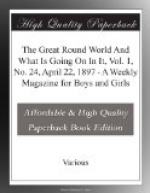The wire is fed to the machine from large reels. It is first cut into the proper lengths by a small steel knife, so arranged that when the regular length of wire is drawn, the knife descends and cuts it off. Next, each small piece of wire, for we can hardly call it anything else yet, is headed by a sharp rap from a small automatic hammer. Lastly, the blunt ends are pointed by passing over a series of rapidly revolving emery-wheels, and the pin falls, the essentially completed article, into a large box, at the rate of three or four per second.
The pins are now placed in large vats, filled with soft soap and water, to be freed from the dirt and grease gathered while passing through the machine. After being thoroughly washed, they are put in the “hopper,” mixed with bran or sawdust, to be dried. The hopper is shaken rapidly, and the clean, dry pins fall out at one side, the sawdust at the other.
The tinning or “silvering” process is next in order. To accomplish this, the pins are put into a vessel containing a solution of cream of tartar and tin, and boiled for four or five hours. From this they come forth bright and silvery-looking, to be dried again as before, previous to the final operation of polishing.
The pins are now ready to be put on papers. The machine which does this is perhaps one of the most ingenious ever constructed. Quantities of pins are thrown from time to time into a rapidly vibrating hopper, which causes them to pass, one by one, into a trough-like slide, that holds the pins by the head; consequently the imperfect ones are automatically rejected. They then slide along a groove to the main body of the machine, where they fall into slits properly distanced, and are pressed into the paper in rows, twelve in all, containing five hundred and sixteen pins.
Shield or safety-pins are made in about the same way, only there are twelve instead of three different stages before the pin issues from the machine absolutely complete. After this it has to be washed and tinned as above described.
The factory has more than fifty machines, which operate themselves so perfectly that they require the supervision of about ten men only.
It has been estimated that more than fifteen thousand gross of pins per day, or five million gross per annum, are turned out by this one concern.
GEORGE C. CANNON.
March 29th, 1897.
=That Rust=
ON YOUR WHEEL CAN BE TAKEN OFF IN TWO MINUTES WITH A RAG AND SOME
=Great Round World Polisher=
PRICE 25 CENTS
FOR SALE BY ALL DEALERS
* * * * *
=EXAMINATIONS=
Have you thought of the Relief
Maps for examination work?
Are you following from day
to day the war in the East?
=Klemm’s Relief Practice Maps=




